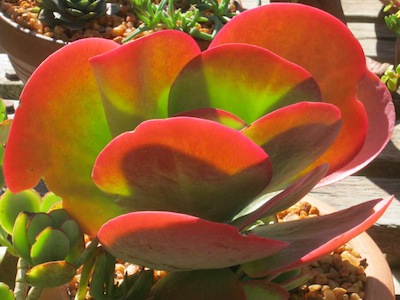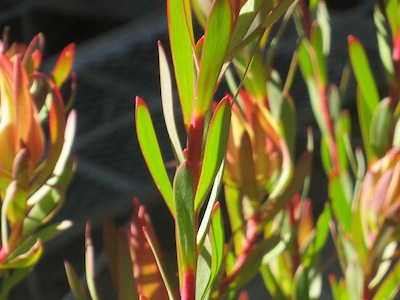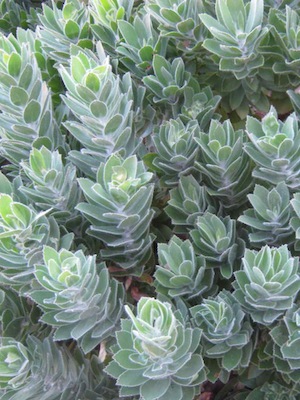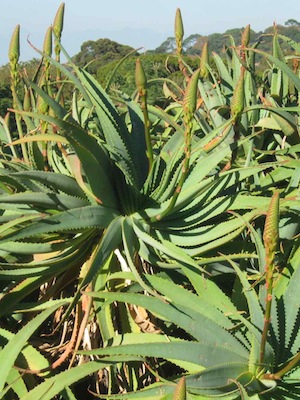Dear Reader, in this age of AI created content, please support with your goodwill someone who works harder to provide the human-made. Sign up at the top of the lefthand column or bottom of this page. You will receive my hand illustrated monthly newsletter RESTORE NATURE and access to the biodiversity garden design course as I write...and nothing else, I respect your time. I am also removing the advertizing as best I can as its become intrusive inappropriate and pays me nothing.
understanding drought tolerant plants
in the Mediterranean climate regions of the world
This page is intended to deepen understanding of drought tolerant plants adapted to dry summers in the winter rainfall regions of the world, from a home gardener's perspective. It is linked to a series of articles on water-wise gardening. You can also access them through the design tab at the top of the page and its drop down menu.
There is a large overlap in our hot dry country with desert plants and the climate zones are continuous. Although we are amateur observers we hope our curiosity and search for explanations helps with useful gardening knowledge for the drought adapted Mediterranean climate regions. I took a trip to Kirstenbosch, our famous National Botanical Garden. It was like a gallery of drought tolerant plants and a library of plant adaptions.
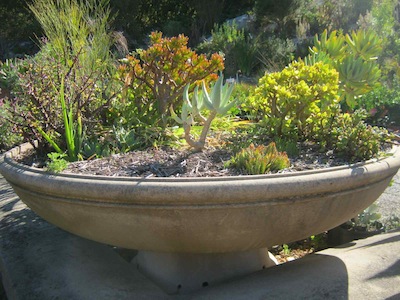 a selection of drought tolerant plants at Kirstenbosch
a selection of drought tolerant plants at Kirstenbosch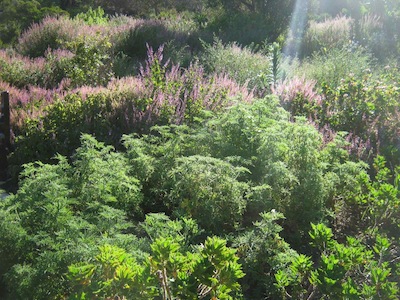 The fine leafed Fynbos, a mechanism of drought tolerance which reduces radiation exposure and harvests mist
The fine leafed Fynbos, a mechanism of drought tolerance which reduces radiation exposure and harvests mistPerhaps because these areas of the world are so minute compared to the rest, we sometimes have to fill in between the lines, making up the shortfall on formal knowledge. Perhaps the details of our indigenous ecosystems and plant culture have not interested most South Africans, not until drought struck us mercilessly. To this event the response in consciousness of water saving has been quite miraculous, like the greening after the first rain.
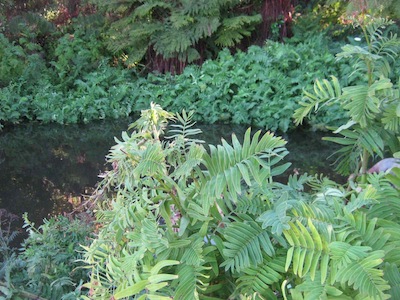 Rare permanent springs because Table Mountain harvests water from ocean winds
Rare permanent springs because Table Mountain harvests water from ocean windsGood sources of information on drought tolerant plants in Mediterranean climate zones
For this page I refer to three main sources of knowledge. Firstly a beautiful book by Heidi Gildemeister (1995) Mediterranean Gardening: A Waterwise Approach. I also refer to book by Ernst van Jaarsveld (2010) Waterwise gardening in South Africa and Namibia. This book is not only on the Mediterranean zone but on all climates of our region. However it gives a localized view on dry climate gardening in which plant adaptions and pressures are different to the Mediterranean. The other source is my 86 year old mother who spent three decades getting to know our local flora. She is an amateur who has received 2 Cape Times conservation medals. I have a PDC certificate, and that locked me onto a desire not just to conserve, but to rebuild ecosystems, alongside human habitation. The first thing to do is to understand how the plants have adapted, so that we can work with them wisely.
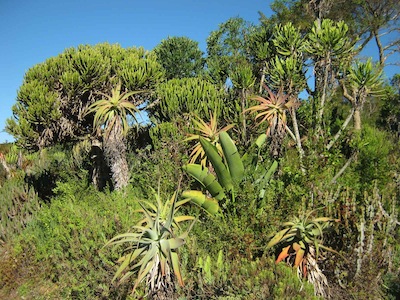 A recreation of the thorny succulent thickets of our distant south eastern coast, with year round rainfall, where elephants feed off resilient herbivore adapted vegetation
A recreation of the thorny succulent thickets of our distant south eastern coast, with year round rainfall, where elephants feed off resilient herbivore adapted vegetationSome differences between the Mediterranean climate zones
We have a lot more sunshine and a lot less rain, with sharper contrasts between the rainy and the drought seasons, and the Cape is hotter than the Riviera, on which Heidi Gildemeister’s book is based. The weather differences were highlighted by my mother because of the plant adaptions which followed on them. Gildemeister also states that South Africa has ‘poorer’ soils. Our mountains are very old compared to the Alps, and very degraded and leached. There are massive areas of limestone rock in Europe which we also don’t have, as I know from my reading on viticulture. This leads into another factor mentioned by van Jaarsveld, and backed up by my studentship of Archaeology at UCT, the lack of large herbivores in the Cape Fynbos, because the poor soils produced vegetation that could not sustain them. My mother also pointed out that intense heat and dryness produces chemicals in plants, byproducts of photosynthesis which result in a spectrum of phytochemicals from aromatic oils to poisons. One of our scented Pelargoniums was the main ingredient of Chanel number 5 in the days when they still used plant extracts. If the Mediterranean has more rain and less sun, then our plants are more poisonous and aromatic in general. These and the hardness of leaf all make our local drought tolerant plants unpalatable.
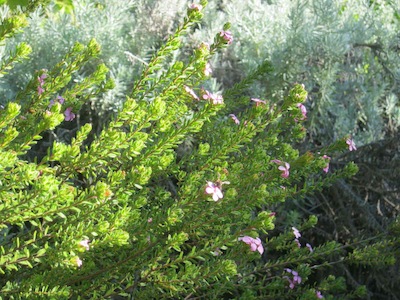 Buchu, in the Kirstenbosch perfume garden
Buchu, in the Kirstenbosch perfume gardenTherefore the Fynbos evolved without much protection from herbivores. This makes the plants sensitive to the slightest disturbance in their proximity. They are also often fire adapted. Lastly, according to my mother, not just our soil, but our flora is older. It was never exposed to the frequent ice ages which erased diversity in the European Mediterranean flora, rich as it is. The Cape flora is therefore more diverse, full of much older remnants, whereas European plants have evolved to invade areas left after an ice age, or to take advantage of the seasonal fluctuations with rapid growth, whereas our plants are slower growers. All these differences make for more tricky horticultural challenges at the Cape.
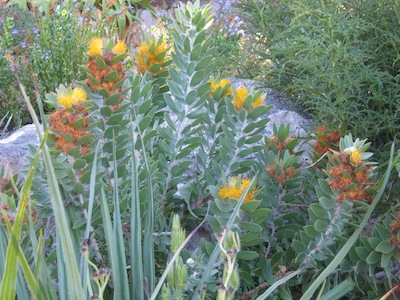 Flowers that are not 'modern' flowers but ancient remnants
Flowers that are not 'modern' flowers but ancient remnantsThe effects of Mediterranean climate on
drought resistant plants
The plants in Mediterranean climate regions have to adapt in order to survive dry summers. The dry summer imposes huge evolutionary pressures on plants. They must survive without water, and in the period of the greatest intensity of sunlight and the greatest heat. Then unlike desert plants which have low rainfall all year, they must maximize on the cold rainy winters, and flourish in the more optimal conditions in spring and autumn. This involves such adaptability, and such stress that the survival strategies are not one of a piece, but several, sometimes conflicting ones.
Survival strategies of drought tolerant plants
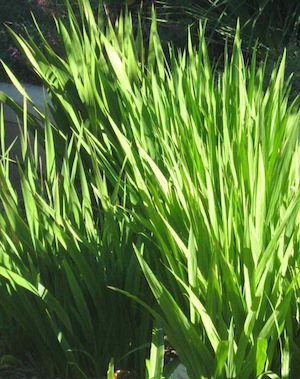 Drought tolerant plants with bulbs, after the first rains
Drought tolerant plants with bulbs, after the first rainsDormancy
in drought tolerant plants
The first strategy is dormancy. Like plants that must survive adverse conditions of extreme cold, the Cape plants may go dormant, but in summer. Dormancy slows the metabolism, growth and need for water and nutrients, allowing them to survive in shut-down mode. The chemical processes in the plant are reactivated when there is adequate water. They go through a cycle of sprouting, growing and flowering and then dormancy (Gildemeister 1995: 22) in the heat and light of summer.
Another kind of dormancy is not seasonal. These are the resurrection plants like moss which according to my mother quickly responds to rain, rehydrating and reproducing rapidly to maximize on a small window of friendly conditions. Lichens in the forest and some desert plants are adapted this way too. The lichens may also photosynthesize with cyanophytes, and have purple chlorophyll, like plants in the stressful intertidal zones. Plants also have alternating types of dormancy, bearing leaves and flowers at different times like the Crinum and Amaryllis referred to by Gildemeister.
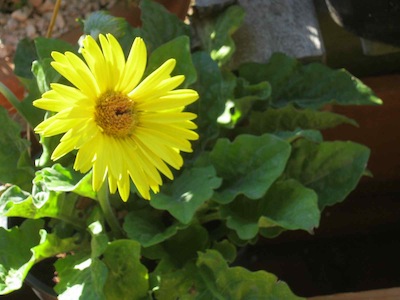 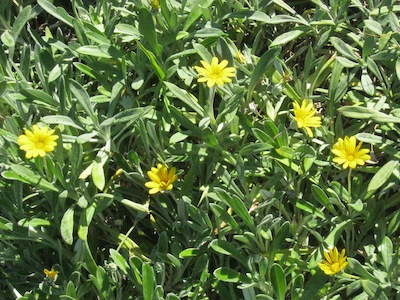 |
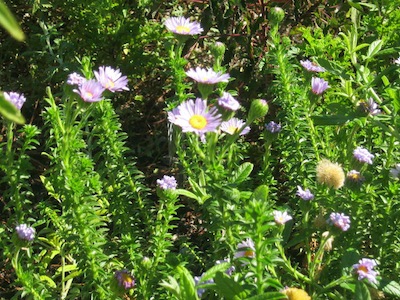 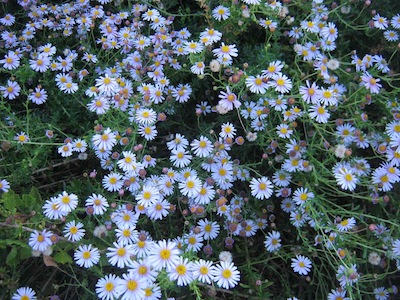 |
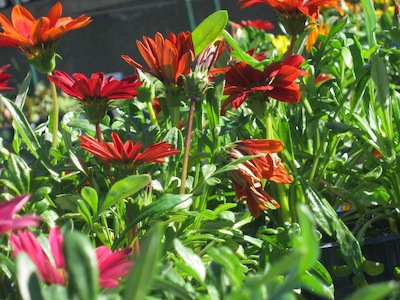 Drought tolerant plants maximize on rain and autumn sun
Drought tolerant plants maximize on rain and autumn sunYet another type of dormancy is complete disappearance. In the friendly season masses of seed may be produced which can withstand adverse conditions until rain returns. The plants die leaving only their seed behind. Other perennial plants may die off above ground while their subterranean parts lie waiting for rain. These types of plants with underground storage organs are called geophytes.
Adapation of drought tolerant plants to growing in microclimates
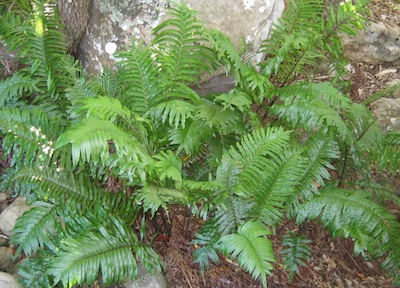 double protection against drying out, these ferns grow next to boulders and in the forest shade
double protection against drying out, these ferns grow next to boulders and in the forest shadePlants also adapt by being able to grow in tiny protected or richly supplied niches. The adabiatic clouds or sea mist dripping off rocks and the cool wet area all around the rock allow plants which like wet feet or even permanent water, to grow in very arid places. Thus we find different plants in boulder fields and along cliffs.
There is also a protected climate under the canopy of trees and bushes, where there is shade, and reduced wind and evaporation, and some plants may evolve for the under storey, adapted to grow beneath other plants.
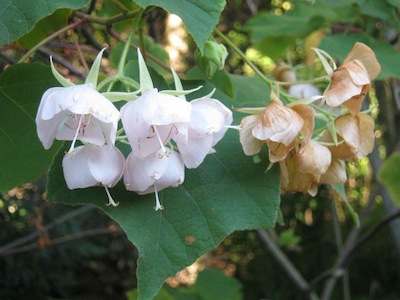 |
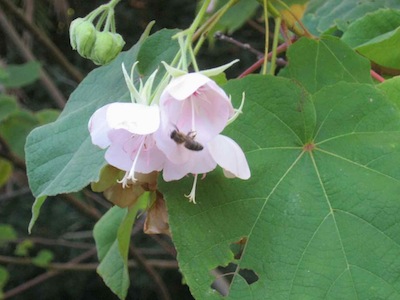 |
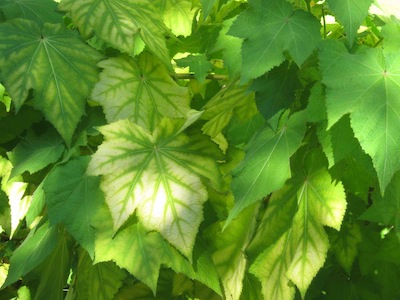 adapted to shade, a niche for drought tolerant plants
adapted to shade, a niche for drought tolerant plantsThe underground parts of drought tolerant plants
Working from beneath the ground up, we will go into greater detail on the adaptions of plants to the harsh summer drought climate, both on the Riviera and in South Africa’s extremes.
As mentioned previously, to survive heat and drought, plants may develop underground organs which survive the summer. They also store water and sugars in these organs. Gildemeister (1995: 23) explains how South African bulbs may need a good summer ‘roasting’ in the soil to flower again. Other plants have adapted, especially in drier areas on the west coast of South Africa (Littlewort, personal communication 2017), to have roots that lie like the coils of a spring beneath the bulbs and can retract them deeper under ground by several inches during the summer heat.
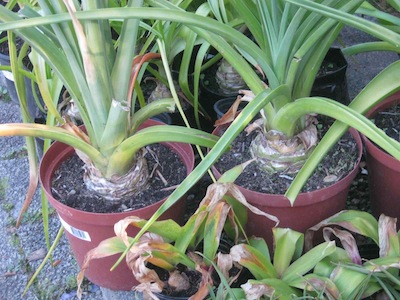 Many drought tolerant plants are geophytes, with underground storage organs and summer dormancy
Many drought tolerant plants are geophytes, with underground storage organs and summer dormancyIn the soil are also mycorrhiza, which by exchanging nutrients in a sort of osmotic process, correct imbalances and optimize the nutritional supply of plants, enabling them to do with less water.
Some plants will send deep roots searching for water while others will have a shallow mat of roots near the surface to catch all precipitation (Gildemeister 1995: 24). This is probably why the Afromontain trees in the Cape have such extensive root mats, whose destruction by tramping feet kills the trees.
The stems of drought tolerant plants
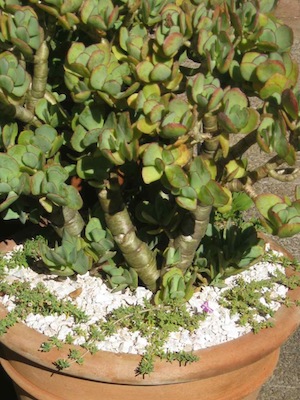 stems store water stems store water |
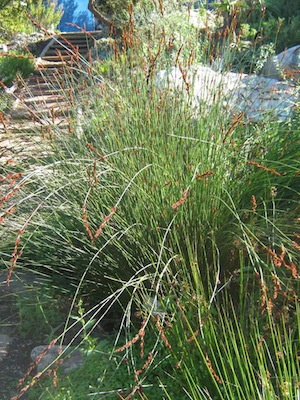 green stems no leaves green stems no leaves |
Above ground the dehydration is more severe. Cork oaks, the dominant forest species in the Western Mediterranean, have evolved thick waxy bark to protect themselves. The dry summer plants also often have more compact growth and thicker stems to reduce dehydration. Water and nutrients may be stored in the above ground parts too. The photosynthetic products which threaten the internal chemical balance of plants may be turned into poisons and deposited in bark or seed husks which are separate from the plant’s vascular system and may be discarded or shed eventually, as if these rough hard materials were an excretory organ (Littlewort, personal communication 2017).
Stems may also exchange roles with leaves, and photosynthesize, to produce some sugars when the leaves have been shed due to drought (Gildemeister 1995: 24). Water normally holds up plants from wetter zones of the world and makes their tissues stiff. Dry habitat plants have to remain rigid without water, therefore woodiness in the plant may predict drought tolerance (Gildemeister 1995: 24).
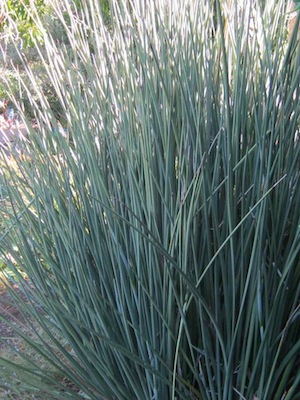 Minimizing sunburn, woody erect leaves. Banana family
Minimizing sunburn, woody erect leaves. Banana familyThe leaves of drought tolerant plants
The leaves of drought resistant plants show a spectacular array of adaptions often achieving multiple benefits that all contribute to survival in adverse circumstances.
The leaves and roots represent the two terminal points of a transportation network. Between them is a continuous column of water, the medium of transport. It is 90% of the plant’s weight and essential to chemical functioning. When the internal water pressure exceeds the plant’s holding capacity the stomata open and water is released into the air. This draws water up from the roots, carrying nutrients to the upper plant. Under drought conditions, transpiration through the stomata exceeds water absorbed through the roots. Plants evolve to close the stomata. They can no longer take up Carbon dioxide, stopping photosynthesis and sugar production. This reduces water exchange with soil and air to a minimum, and the plant can survive extended periods of dormancy.
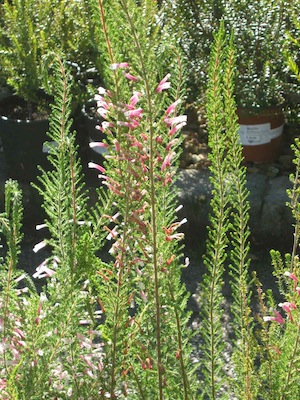 Feathery foliage harvests dew, evades sunburn, tubular flowers specialized for bird or long tongued fly pollination
Feathery foliage harvests dew, evades sunburn, tubular flowers specialized for bird or long tongued fly pollinationLeaves are the main organ of photosynthesis. Light energy is converted by chlorophyll to sugar in the process. If the light is of too high intensity it destroys chlorophyll, reducing food production. The lack of water likewise reduces food production as it is the medium in which the chemical reactions occur. But strong radiation increases evaporation. The closing of stomata means they need less water, fewer nutrients and less soil to absorb water from. They can become so static that they survive off sporadic desert rain.
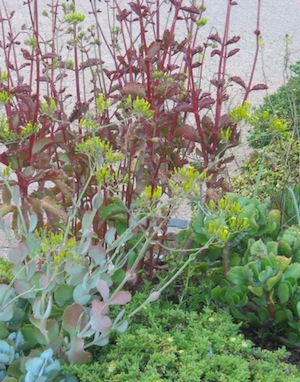 Drought tolerant succlent plants and CAM metabolism
Drought tolerant succlent plants and CAM metabolismTropical plants have evolved a specialized metabolism to cope with this. Named after the Crassula family it is called the crassulacean acid metabolism (CAM). They need only take in Carbon dioxide at night and it is stored until the light returns. (Gildemeister 1995: 24).
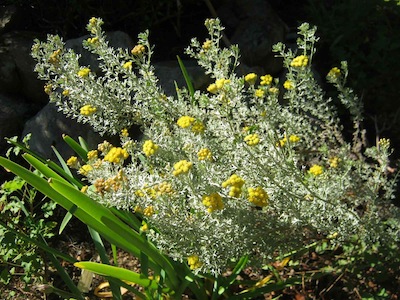 Helichrysum in Kirstenbosch perfume garden
Helichrysum in Kirstenbosch perfume gardenDespite adaptions to reduce photosynthesis, an excess of its byproducts may build up in plant tissues when light is strong. Without water to dilute these the concentrations threaten the life of the plant and the byproducts of photosynthesis must be converted into other molecules, or secondary metabolites. The concentrations of these is also a threat, and plants evolve to isolate them. They are enclosed in oil droplets or microscopic sacs, as aromatics, or even poisons, because water and oil do not mix, or they may deposited in tissues that can be separated off and discarded like bark, fruit and seeds. The same plant grown under different conditions may show different toxicity (Littlewort, personal communication 2017).
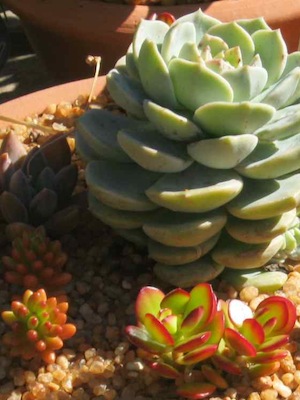 grey skin from wax layer grey skin from wax layer |
 grey skin from fine hairs grey skin from fine hairs |
protective leaf coverings
The leaves may have protective mechanisms visible to the naked eye. There are natural sunscreens, reddish in colour, found more often in young delicate foliage and in succulents under extreme conditions of stress (Littlewort).
They may have a thick cuticle that reflects light, microscopic scales that slow evaporation and give the plant a whitish tint. They may have water repellent gaseous layers of ethereal oils on the leaf surface, or fine hairs, both of which maintain water vapour pressure at the surface and reduce water loss. Leaves and green parts may have thick waxy covers. Evergreen leaves may have a tough skin and be hard (sclerophyllous) or spiny. They may be needle like or small to reduce their surface area. The stomata may be sunk in cracks visible as ridges (Gildemeister 1995: 24).
The growth patterns of drought tolerant plants
The whole plant may be structured in such a way as to survive drought, both in space and time. Evergreen leaves usually last several years, conserving scarce resources. The annual growth may be slow, stunting the plant, and leading to uniform compact size and a cushion shape which also reduces evaporation. Cork oak is a large example, the cushion form of cliff top plants is another. The dense canopy and the aerodynamic cushion shape reduce evaporation caused by wind.
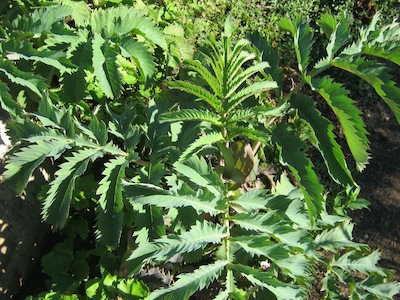 drought tolerant plants: folding or finely divided leaves
drought tolerant plants: folding or finely divided leavesCareful leaf patterning may create shade in the centre, and radiation impact is minimized by leaves folding closed in the peak sunlight hours, positioning vertically, reduction of leaf size, and divided pinnate leaves, as in Fatsia, Ricinus and Palms. Some plants may harvest water. The forest boekenhout (wild beach) has elbows in the leaf petiole, which give way under the weight of rain and direct water to their roots. Plants with tiny pointed leaves like moss can harvest water from the misty air, and carry up to ten times their own weight in water (Littlewort personal communication 2017).
Seasonal and succession patterns of plants
Over the seasons, in time, radiation exposure is reduced by summer deciduousness, leaf loss and dormancy (Gildemeister 1995: 24). On the Riviera, evergreens only start to grow in spring, and deciduous trees begin with blossom and then carry leaves in summer (Gildemeister 1995: 23). This behaviour would kill a plant in some areas of the Cape Fynbos biome, without extra irrigation which exotics like peaches receive. To make the most of the rainy season, bulbs may sprout leaves in autumn, or flower. Annuals may start to grow from seed using the winter rains to grow vegetatively before they flower in spring. (Gildemeister 1995: 23) Generally plants start to grow in autumn, and it is the same at the Cape.
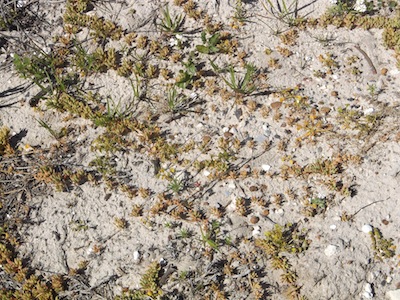 drought tolerant plant pioneers with long runners
drought tolerant plant pioneers with long runnersThe first annual rains create ground cover on dry baked
ground. Like seasonal pioneers, they improve conditions for the next generation
following the next downpour. These
ground covers sprout runners which can be 30 to 200 centimetres in length. My
mother mentioned Tracheandra as a good example, also Hebenstretia. Gusty spring
winds blow seeds into these runners, and the seeds can germinate in their shade
and the protected environment created by a network of trailing vegetation on
the ground. On a larger scale, pioneer plants create more hospitable microclimates
for climax vegetation, and leaf canopies, whether low and small or tall, create
a comparitively stiller, cooler, wetter, darker climate beneath them for other
plants to thrive. This is not just found in the ‘Mediterranean’ zones, but is
an ecological universal.
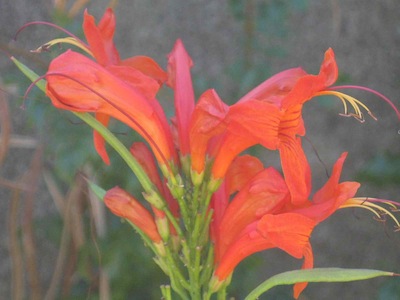 drought tolerant plants may adapt for bird pollination
drought tolerant plants may adapt for bird pollinationThe sexual parts of drought resistant plants
flowers
The evolution of flowers for this climate does not not feature much in gardening literature. I have to draw my own conclusions. After a long summer drought, plants grow vegetatively and many only flower with the onset of the summer. This means that honey bees would starve. There is always something flowering, but nothing like the sheets of spring flowers. At this time a lot of seed is produced by ephemeral annual plants capitalizing on the combination of warmth and water (Gildemeister 1995: 23). The rest of the year cannot sustain vast populations of honey bees. The flowers must be pollinated by other vectors, by wild bees with small hives that do not demand so much in terms of food, by flies, ants and other omnivorous insects and animals.
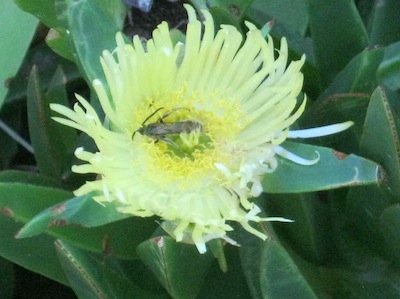 beetle pollinator and possible predator
beetle pollinator and possible predatorIndeed, flies, beetles and ants pollinate a large number of the west coast flowers, I remember my mother saying this. Indigenous ants also carry the seed into underground burrows dispersing it and readying it for the day the rains come. When exotic ants take over, the flower population may crash. The plants are further endangered by very species specific pollinator relationships, that can lead to the extinction of the plants. Many kinds of interference are drastic, from the obvious use of insecticides, to hoeing beds, which kills fly larvae. For those flowers which appear out of season, like Crinum and Amaryllis, there is an advantage in being the centre of attention for hungry insects. These flowers bloom in the summer heat (Gildemeister 1995: 23), and without any leaves, protecting themselves from the dangers of carrying leaves in summer.
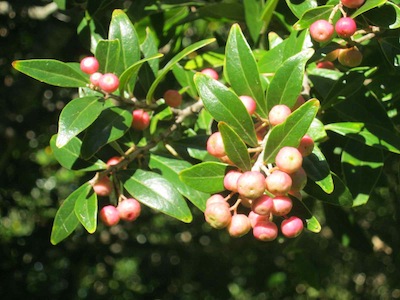 Drought tolerant plants producing lots of small hard fruit
Drought tolerant plants producing lots of small hard fruitfruit
I’ve observed that the fruit in our Fynbos biome are small and conserve resources, and if large, like Carpobrotus edulis, have many many tiny seeds housed in their mucilaginous inner spaces. Our berries are also more poisonous than those in Europe. This is a direct consequence of shedding secondary metabolites from photosynthesis, but they also protect the tiny berries from being eaten by large mammals with corrosive stomach acids. However, the strategies are too diverse to generalize, which may be why fruit evolution isn’t prominent in the story of summer drought survival either.
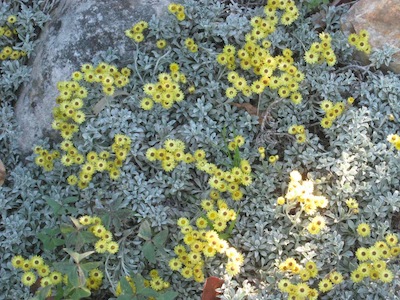 drought tolerant plants with papery 'everlasting' flowers and tiny wind dispersed seed
drought tolerant plants with papery 'everlasting' flowers and tiny wind dispersed seedseed
Seeds themselves are time capsules made for survival and have evolved many ways to ensure that they can germinate at favourable times. They need to hold out for the right conditions lying in the ground as seed banks for years (Gidlemeister 1995: 24). Many of our plants can germinate after decades when the conditions are right and there is a combination for instance, of recent fire followed by rain. They may have hard shells which require the nibbling of insects, or a good deal of swelling and softening by water before the embryo can expand. They may be covered in a layer of germination inhibiting chemicals, which need to be washed away by numerous rains. Some like Buckbay veygies have tiny valves in the seed coat which open when wet to take water in (Littlewort). The sheer numbers of seed produced by carpets of annual flowers may ensure survival.
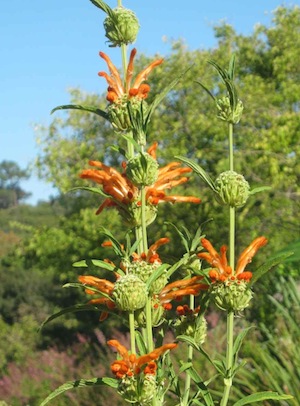 Leonotis, a drought tolerant plant with stately seed 'balls'
Leonotis, a drought tolerant plant with stately seed 'balls'Protective eco systems help with drought survival
The whole ecosystem also collaborates in the survival of its parts and members. There is the succession of plants from pioneer to climax vegetation, through time. Then by their structure, leaf canopies protect the space beneath them in which other more fragile plants may grow. This is never so true as in the dry summer regions of the world.
According to Gildemeister, most of the Mediterranean region was once covered by forest. Starting with Solomon’s harvest of the cedars of Lebanon a steady process of denudation has occurred. The forest cover has gone from 70 to 3%. The garrigue and maquis vegetations are signs of environmental degradation.
Where are the Fynbos forests ?
If forest is climax vegetation, even in the brittle Mediterranean climate, we appear to have no forests in the Cape winter rainfall area. This ‘fact’, that we have no forest and the ‘Fynbos’ has no trees, is often proclaimed in environmental discussions online. The famous Strandveld, Fynbos and Renosterveld we ‘know’ are only head high at the maximum and mostly lower. However, that we have no forests is a popular error.
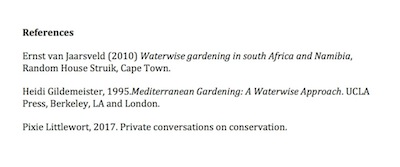
------
home page for links to useful ideas on natural gardening
------
------
------
Planning your planting in a Mediterranean garden
------
album of lawn replacements and ground covers
------
waterwise Mediterranean gardens
You’re a home gardener ! Share your experiences and questions !
We all know about home gardening. Tell us about your successes, challenges and ask about issues that bother you. You may have the luxury of a back garden, but there are other ways we learn. Few people age without growing something or buying vegetables during their lives ! It is absolutely guaranteed that you have learned things which can help others on their gardening journey.
We invite you to share your stories, ask questions, because if a thing has bothered you it will bother others too. Someone may have a solution ! No question is too small. There is learning for everyone involved, for you, for me (yes, I learn from every question), for us all. Exciting stuff !
We are starting on a new journey. Every week we will profile your letters ! The best stories and questions we receive.
What Other Visitors Have Said
Click below to see contributions from other visitors to this page...
Are drought tolerant plants the same as desert plants ? 




What is the difference ?
There is a fine line between summer drought tolerant plants and desert plants in our various South African climates. Year round …
Restore Nature Newsletter
I've been writing for four years now and I would love to hear from you
Please let me know if you have any questions, comments or stories to share on gardening, permaculture, regenerative agriculture, food forests, natural gardening, do nothing gardening, observations about pests and diseases, foraging, dealing with and using weeds constructively, composting and going offgrid.
SEARCH
Order the Kindle E-book for the SPECIAL PRICE of only
Prices valid till 30.09.2023
Recent Articles
-
garden for life is a blog about saving the earth one garden at a time
Apr 18, 25 01:18 PM
The garden for life blog has short articles on gardening for biodiversity with native plants and regenerating soil for climate amelioration and nutritious food -
Cape Flats Sand Fynbos, Cape Town's most endangered native vegetation!
Apr 18, 25 10:36 AM
Cape Flats Sand Fynbos, a vegetation type found in the super diverse Cape Fynbos region is threatened by Cape Town's urban development and invasive alien plants -
Geography Research Task
Jan 31, 25 11:37 PM
To whom it may concern My name is Tanyaradzwa Madziwa and I am a matric student at Springfield Convent School. As part of our geography syllabus for this
"How to start a profitable worm business on a shoestring budget
Order a printed copy from "Amazon" at the SPECIAL PRICE of only
or a digital version from the "Kindle" store at the SPECIAL PRICE of only
Prices valid till 30.09.2023
